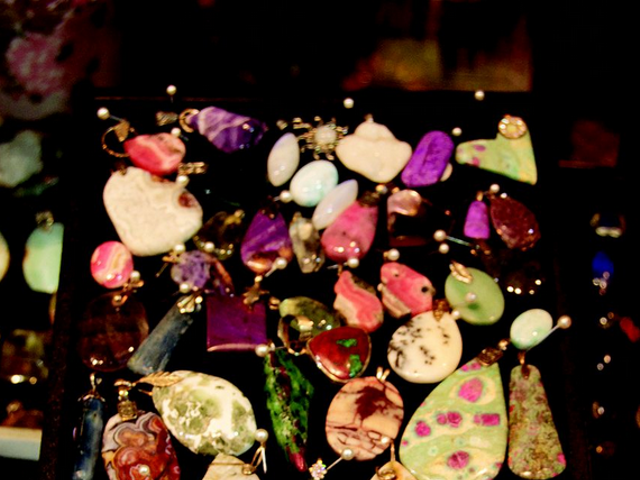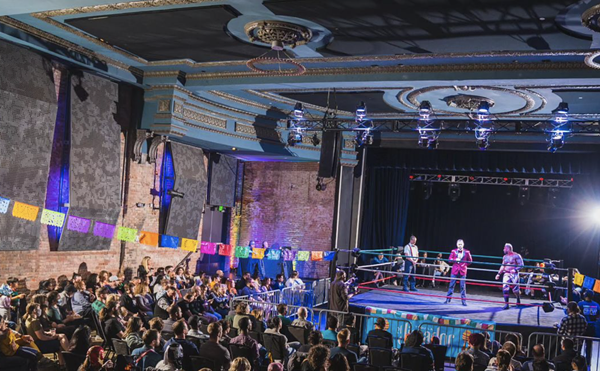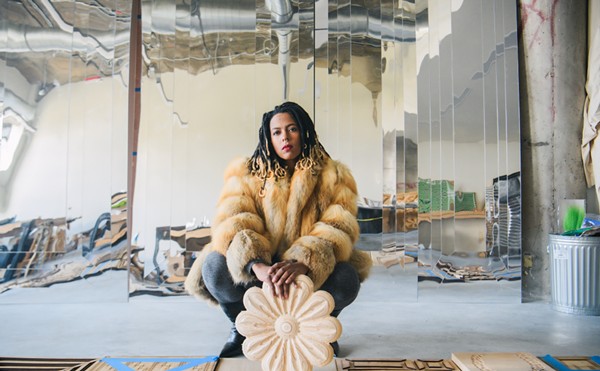We're pretty good at butchering French words here in Détroit. That's partially why you didn't see the words Nuit Blanche anywhere to promote Dlectricity in 2012, the inaugural year of Detroit's outdoor festival of sights and sounds. While there are other Nuit Blanche festivals in the world, it's not a brand — it simply refers to any all-night arts festival, as made popular in Paris.
It seems this year, though, Detroit is ready for that extra cosmopolitan sheen, with "Nuit Blanche Detroit" now Dlectricity's official tagline. "We really do want this festival to be known in this light, especially internationally. It adds to the cachet of the festival," says Annmarie Borucki, special projects manager for Midtown Detroit, Inc., which produces the event.
"I'm sure we'll get a lot of people who ask us what 'nooey blanche' means," she jokes. "That's OK. That's our job, to educate."
If the goal of the inaugural Dlectricity was to put Detroit on the level of that international community of art cities, at least in the mind of Detroiters, then it was a success. "The biggest compliment we got from people — and we heard it often — was, 'Oh my god, this really looks like a real city. This is something you would only see in Paris or Berlin, but we're seeing it here in Detroit,'" Borucki says.
There are some notable differences with Detroit's version of the festival, though. For one, other cities' Nuit Blanche festivals occupy many neighborhoods. Detroit's is concentrated in a mile-long footprint from the Cultural Center district down to the Max M. Fisher Music Center. It also won't be an all-nighter, with festivities winding down at midnight.
Borucki says the festival is about "creative placemaking," or using the arts to enhance the quality of life of a space. "Having travelled to see some of these other festivals in Toronto and across the country, we knew Detroit would be perfect for it because we have the architecture in place, the cultural assets in place, the artists in place, and the ability to bring in national and international artists," Borucki says. "Our role is really about enhancing Midtown, and showcasing what's there, and also getting people to feel comfortable in coming out to Detroit at night, coming to our restaurants, and coming out to bars. It's about the arts, but it's also about the development."
It's also about getting people to actually get out of their cars and walk the streets of the Motor City for a change. "Last time our footprint was bigger, and we knew we needed to tighten it up," Borucki says. "That was a good lesson we learned, to keep it walkable. If you have projects too spread out that people have to walk two blocks to get to, you lose people." Borucki also says they tried to incorporate more buildings this year. "We're trying to spread the wealth in who we're trying to promote and present here," she says.
Dlectricity differs from traditional arts festivals in that it leans more toward technology. Many of Dlectricity's installations involve projecting videos onto buildings, robotics, and other mixed-media performances. "I think that's why Dlectricity is great, in bridging those worlds between arts and technology," Borucki says. "I also see more and more artists trying to learn technology and incorporating it into their creative practice. It's amazing how many older artists that are trying to learn these skills to be able to do different things, to make themselves more interesting. It's hard to just be a painter nowadays. The last time we had a painter at Dlectricity, he worked with someone who animated his paintings and brought them to life."
Borucki says 10 of the 35 participating artists were invited by Dlectricity's curatorial committee, and the rest came from an open call for entries. She adds that the installations are largely paid for using philanthropic dollars from a number of foundations.
Of the installations that were chosen, Borucki says "artistic excellence was the number one thing." She says that use of technology, interactivity, economic feasibility, site-specificity, and an educational component were also factored into the decision-making process. "You can't meet all those criteria with every project," Borucki admits. "You're trying to find a balance of that."
Borucki says festivalgoers can expect the ante to be upped with participating artists this year. "They're not household names, but they're definitely people to watch out for," she says. "I feel that we're the type of festival that brings in people before they're famous."
For example, a video by the New York-based contemporary artist Sue de Beer celebrating the Leland City Club, Detroit's goth club, will be projected on the Detroit Historic Museum facade. Australian artist Shaun Gladwell has a two-channel video on MOCAD that pairs audio of beatboxers with video of breakdancers. And the Canadian artist Kelly Richardson will exhibit one of her existing pieces projected onto the facade of the Michigan Science Center that involves a strange, sci-fi landscape. Borucki won't spill the beans on the details, but promises it will be special. "It's one of those things that when you're walking down Woodward you're going to see it out of the corner of your eye and you're going to be like a fly drawn over to the light," she says.
As far as Detroit-based artists go, Adam Lee Miller and Nicola Kuperus made a video involving a loop of a masked woman repeatedly sitting on whoopee cushions, which will be projected on the back end of functional porta-potties (with audio piped inside). Borucki thinks it will be a hit. "Their videos are extremely well done. They're always extremely kooky," Borucki says. "This was definitely a crowd pleaser within our curatorial committee." Other Detroit-based artists include Aric Miller and Molly Soda, who will recontextualize Tumblr-based GIF animations from 20 artists' blogs by projecting them on a wall. There's also the group Apetechnology, which has created a 20-foot tall moving crystalline robotic construction. And an installation by Detroit-based firm Mindfield involves a 3-D mapping project on the facades of the Detroit Institute of Arts and the Detroit Public Library. "It's developed and designed by a Detroit firm. It was produced in Detroit. Their actors are Detroit-based professionals. It's just kind of cool to have something that's all inclusive for Detroit," Borucki says.
Borucki says that the event is a great way for artists and creative firms to get noticed, noting that New D Media landed a gig animating the Diego Rivera murals for a gala event at the museum based on the work they did at the inaugural Dlectricity. It's also a great portfolio-building opportunity. "I think of Mindfield — their bread and butter is the automotive scene, but they also get a lot of gigs with some of the sporting teams. But they do a lot of work in Hollywood as well," Borucki says. "Something like this, this is the project that everyone dies for. You can finally do something solely creative. It's fun, and it's creative, and it showcases your portfolio instead of having to meet your clients needs."
These "small, scrappy, flexible firms," as Borucki describes them, are also prone to working together behind the scenes. "It's kind of great that everyone wants to work together. I don't know if that happens in other cities," she says. "But at least here in Detroit there is that type of cooperation. Everyone wants everyone's festival to do well. It's a cool project and it keeps people in business."
Borucki says most of the installations are outdoors, but some are inside. "The Cathedral Church of St. Paul, the sanctuary is so beautiful," she says. "It's a great space to get people indoors to see." This year, Zackery Belanger, a scientist who studies acoustics, has designed a visual simulation of what the acoustics are inside of the sanctuary. It's an opportunity to mix science, art, and technology — and inside of a historic Detroit church, no less.
With so many moving parts, it's a wonder how a project can see completion from initial pitch to final production. Borucki admits there was a learning curve. "There's a lot more communication between us and the artists," she says of this year. The curatorial committee had judge more than 350 applications, and then vet the top 60 projects for feasibility only to whittle it down to the final 35. "What that means is you're doing a budget analysis, and you're doing a site review," she says. "You're talking to the artist, you're interviewing them to see if they even have the ability to pull this project off, and looking at their past portfolios. It's a lot of work."
Borucki says her camp is also involved in keeping the production aspect on track. "We have a lot of artists who have great ideas and they just get crazy and they want to keep going further and further, and you're trying to rein them back in," she laughs. "We do have some powers that way. We're definitely not a democracy here. You want it to be a tightly curated event, and you want the projects to be what they said they were going to be. We have those honest and open conversations with people. Most people are willing to work with us, because they really want to be in the festival. This time, I think we've been so tightly involved with every project that we know what we're getting."
Borucki says planning for 2014's Dlectricity began "the day after the last Dlectricity," and says they've been working on it solidly for a year and half, which is why the festival is currently biennial and not annual. The current plan is to have the event alternate with the Art X Detroit Kresge Fellowship showcase, with both events syncing up with the annual Detroit Design Festival.
While Detroit's Nuit Blanche may not be as robust as other cities around the globe, Borucki still thinks the work they've done in Detroit is unparalleled. "I feel like we're the poster child of creative placemaking for the country. I really do," she says, thanks to the support from various foundations in investing in public arts projects like this.
"Sometimes a festival like this may not neatly fit into their mission, but they find a way to fund it anyways, because they know it's important on so many different levels — economically, what it does for Detroit's persona, and developing a more positive image," Borucki says. "It all comes together in the end." — mt
Dlectricity is Sept. 26-27, at various locations. See dlectricity.com for more information.






